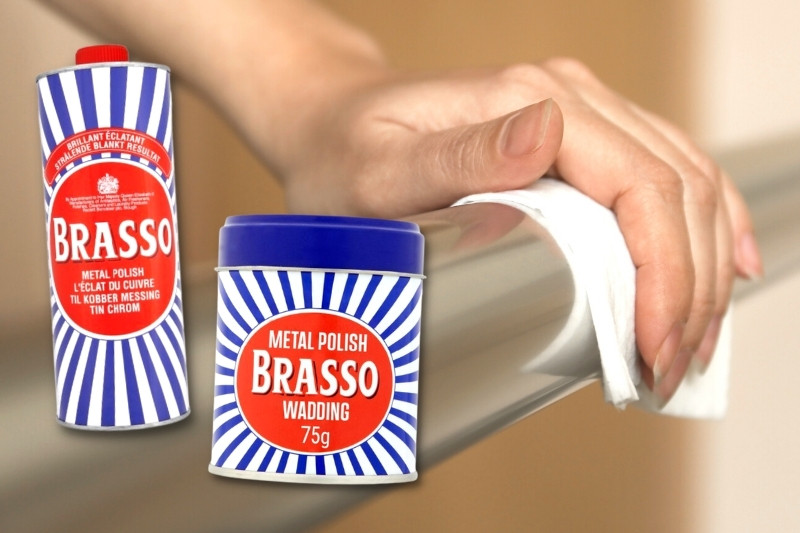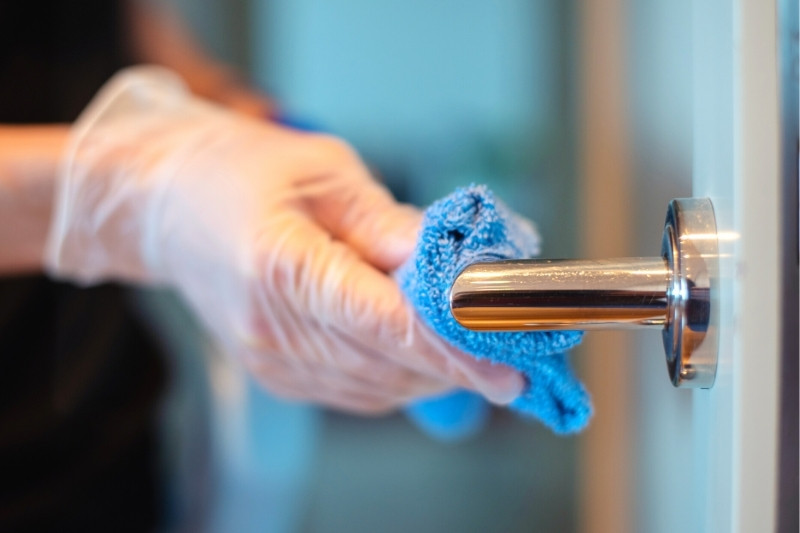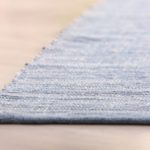Using Brasso to clean and polish grotty metal surfaces is super easy, and doesn’t cost you a fortune!
This classic metal polisher can turn dulling surfaces into shiny wonders with just a quick wipe and a buff.
But what else can Brasso do? Find out how to use Brasso and what it can do below.
What Is Brasso and What Is It Used For?
Brasso is a well-known metal polisher, that can be used to polish, remove tarnish and clean up chrome, stainless steel, copper, and of course, brass.
You can pick up Brasso in liquid form or you can buy it in wadding form.
If you buy a liquid can of Brasso, you need to pour a small amount of the can’s contents onto a clean cloth to use the solution.
If you buy a can of wadding Brasso, you’ll get thick pieces of material inside the Brasso tin that have been pre-treated with the Brasso solution.
This, in turn, means that you can quickly remove the wadding from the tin and use it straight away to polish a surface. You don’t have to waste time pouring the liquid Brasso onto a separate cloth in order to polish items.
What can Brasso clean and polish?
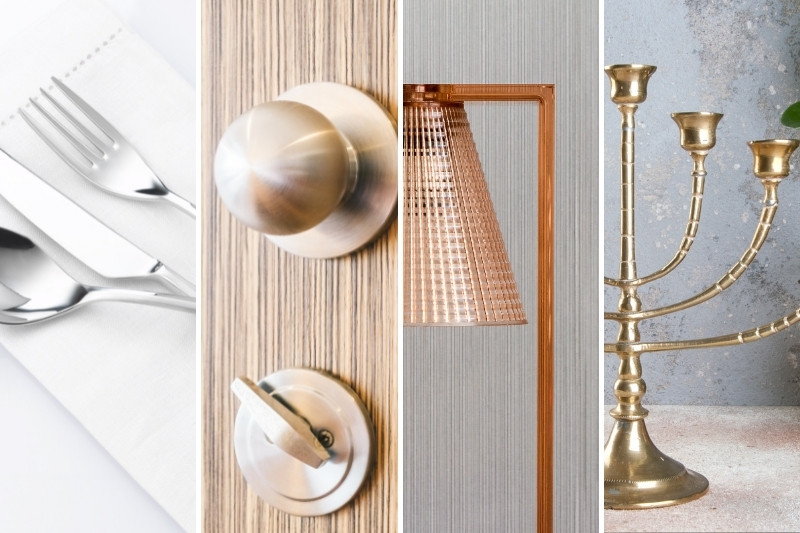
Here are some examples of where you could use Brasso:
- Silverware
- Door knobs and cupboard handles made of metal
- Metal or copper lamps
- Belt and shoe buckles
- Treating metal taps
- Stainless steel pots and pans
- Candle stick holders
- Metal picture frames
How Do You Use Brasso?
Below you’ll find steps on how to use Brasso in both liquid and wadding form. Skip to the section that applies to the Brasso you’ve bought.
General tips to think about before you start using Brasso:
- Always do a patch test – Make sure the product is suitable for the material you’re cleaning.
- Always use clean cloths when working with Brasso – This will limit the transfer of dirt.
- Always wear gloves and a mask – Brasso can cause skin irritation and inhaling the fumes may lead to drowsiness.
- Use small amounts of Brasso at a time, and add more product as you go – If you use too much Brasso you run the risk of it dripping everywhere as you use it, especially the liquid form, this is wasteful.
- Brasso is flammable so keep it away from live flames.
- Don’t leave a job half done – Once you start using Brasso to clean a surface, you should finish cleaning the surface in one go. If you leave the surface to dry, you’ll have Brasso residue. And as a consequence of this, items might not look shiny and evenly cleaned.
- You should remove Brasso from small nooks before it dries – Use a small, slim tool that’s wrapped in a cloth to tease the excess Brasso from crevices. Leaving the Brasso to dry will just make it harder to remove, and you might not end up with the sleek finish you were after if there’s Brasso residue all over the place.
How to clean with liquid Brasso:
- Check the item you are about to polish is actually metal.
- Pop some gloves on to protect your hands from the Brasso.
- Shake the can of Brasso well before opening it.
- Grab a clean cloth and pour a small amount of Brasso onto it.
- Perform a small patch test to make sure the Brasso doesn’t mark or stain the surface you’re about to polish.
- If all is well, continue with this method.
- Pop some more Brasson onto your cloth.
- Start to wipe the surface you want to clean with Brasso in a small but circular motion.
- Continue to do this.
- Regularly wipe/buff the already treated surface with a new clean cloth to see how you’re polishing exercise is going.
- Repeat the steps above until the entire surface has been cleaned.
- Remove any excess Brasso with a clean cloth and buff the surface.
Tip: If you’re using liquid Brasso, always pour the liquid from the can onto a clean cloth. Do not hold a cloth over the mouth of the can because this transfers dirt into the can. This then contaminates and weakens the Brasso inside the can.
How to clean with wadding Brasso:
- Check the item you are about to polish is actually metal.
- Pop some gloves on to protect your hands from the Brasso.
- Remove a piece of wadding from the tin.
- Gently rub a piece of Brasso wadding onto the surface you want to clean to perform a small patch test – make sure the Brasso doesn’t mark or stain the surface you’re about to polish.
- If all is well, continue with this method.
- Continue to rub the wadding all over the surface you want to clean – use a circular motion.
- Continue to do this until you’ve rubbed down the entire surface.
- Regularly wipe/buff the already treated areas with an additional clean cloth to see how you’re polishing exercise is going.
- Repeat the steps above until the entire surface has been cleaned.
- Remove any excess Brasso with a clean cloth and buff the surface.
Note: You’ll likely have to use more Brasso for tougher, dirtier spots! And if your Brasso cleaning cloth goes dry, add more liquid Brasso to it or use a new piece of wadding.
Benefits of using Brasso
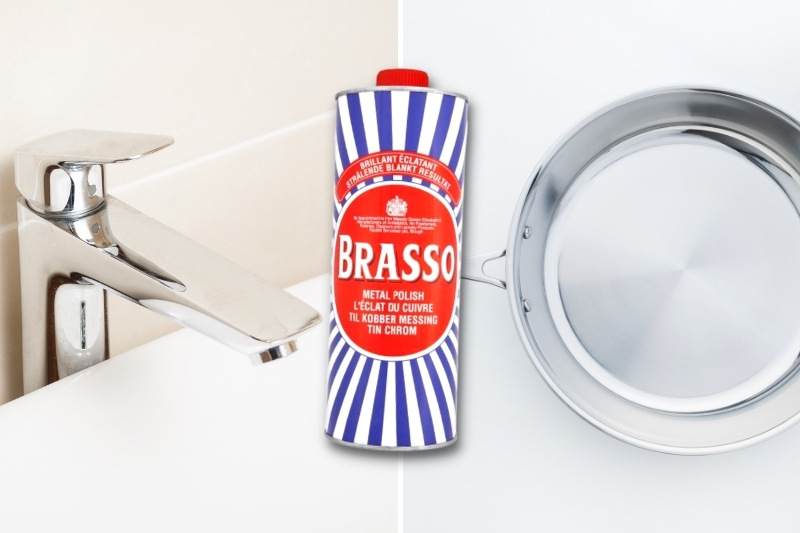
Here are the main benefits of using Brasso:
- Easy to use.
- Easy to find in shops.
- Can remove grime and grease from surfaces.
- Brings a new lease of life to metal items.
Drawbacks of using Brasso
Here are a few negatives of using Brasso:
- You’ve got to put some elbow grease into the cleaning exercise – it’s not just going to work on its own.
- The smell isn’t to everybody’s taste.
- Cannot be used on all surfaces.
- Brasso is flammable.
- It can cause skin irritation.
Looking after your Brasso when you’re done cleaning
When you’re done using your Brasso you need to store it away in a safe place, that is out of the reach of children and pets.
Make sure the lid has been put on tight.
Where Can You Buy Brasso?
Brasso can be bought from most hardware stores and supermarkets. You’ll typically find it near to, or in, the cleaning products aisle.
Keep an eye out for a blue and white striped pot that has a big red label on the front, with the name ‘Brasso’ on it.
How Long Do You Leave Brasso on a Surface For?
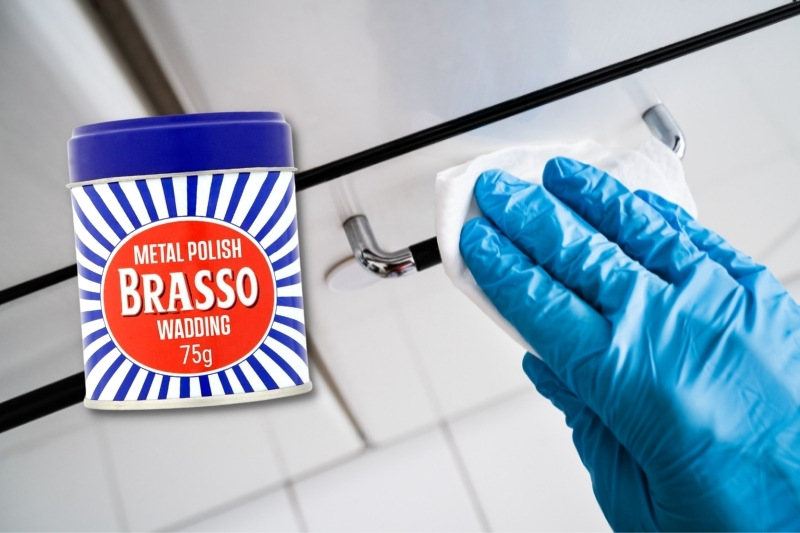
Brasso, if used correctly, will naturally be worked into a surface, and any residue will be buffed away by a clean cloth at the end of the exercise.
How long this exercise takes you to complete depends on what you are polishing.
Should You Wipe Brasso Off Surfaces After Cleaning?
Technically speaking, as you continuously massage Brasso into the surface you’re polishing, you will be wiping some of the product off as you go. This is what’s supposed to happen.
In addition to this, if you’ve used an appropriate amount of Brasso, and you’ve worked it into a surface and then buffed the surface again, you shouldn’t really have any excess Brasso left behind. So, you won’t need to ‘wipe Brasso off a surface’ per se.
If you do have Brasso residue leftover, either keep buffing it off the surface or use a clean cloth to remove it.
Can You Rinse Brasso Off with Water?
If the surface permits, you can rinse Brasso off it with water.
Although, if you’ve used an appropriate amount of Brasso for the surface you need to clean, and you’ve worked the Brasso into the item and buffed it as well, there shouldn’t be any need to remove the Brasso with water.
The Brasso should be dry enough by the time you’re done, and will dry further via natural means.
How Do You Remove Dried Brasso Residue?
If you’ve got some stubborn Brasso that needs to be cleaned away, follow these steps to get rid of the troubling Brasso:
- Fill a cup with warm water.
- Add a teaspoon of washing up liquid to this water.
- Dip a clean cloth into the soapy water and wring out excess liquid.
- Rub this cloth over the area you want to clean.
- Continue to do this until the patch is clean – you might need to apply more pressure to certain grimey patches.
- Wipe the surface with another dry clean cloth.
Tip: You can also use this method to remove old Brasso off surfaces too.

Bethan has a passion for exploring, reading, cooking and gardening! When she’s not creating culinary delights for her family, she’s concocting potions to keep her house clean!
